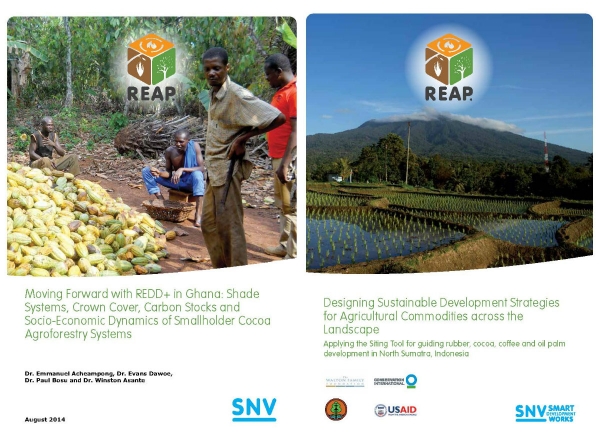SNV's new reports on Sustainable Development and Agroforestry Systems

SNV's REDD+ Energy and Agriculture Programme (REAP) recently published two new reports to share data and recommendations on sustainable agricultural development across landscapes and smallholder agroforestry systems. More details below.
Designing Sustainable Development Strategies for Agricultural Commodities across the Landscape: Applying the Siting Tool for guiding rubber, cocoa, coffee and oil palm development in North Sumatra, Indonesia
SNV has developed a Siting Tool to guide sustainable agricultural development in forest-agriculture landscapes, taking into account biophysical suitability and conservation values as well as the impacts of climate change. The tool has been tested in North Sumatra, Indonesia, to formulate recommendations on the development of four commodities driving land use change - coffee, cocoa, palm oil and rubber.
For each of these agricultural commodities, the Siting Tool was applied to generate a Risk Indicator Map, providing a visual representation of the risks and opportunities of agricultural expansion in the landscape. The findings allow trade-offs to be examined and contribute to the development of a long term vision for sustainable growth of the target sectors in the region.
Moving forward with REDD+ in Ghana: Shade Systems, Crown Cover, Carbon Stocks and Socio-Economic Dynamics of Smallholder Cocoa Agroforestry Systems
Cocoa is one of the most widely cultivated tree crops in tropical West and Central Africa. Traditional cultivation systems whereby cocoa farms are established under the native forest canopy offer better opportunities to store carbon and mitigate climate change than agricultural land uses whereby large timber species are removed. Unfortunately, cocoa farmers are increasingly shifting to no-shade production systems, posing a threat to the sustainability of the sector.
SNV funded a research to examine the impact of forest canopy and forest tree diversity on cocoa agroforestry systems and the implications for REDD+. The objectives of this study were to quantify the baseline carbon stocks in different smallholder cocoa farming systems, identify land and tree tenure challenges, analyse farmers’ perceptions of trees in cocoa farms and assess the feasibility of implementing REDD+ interventions in cocoa landscapes. This document presents the approach of this study and the findings and outcomes from the field.

Facebook comments